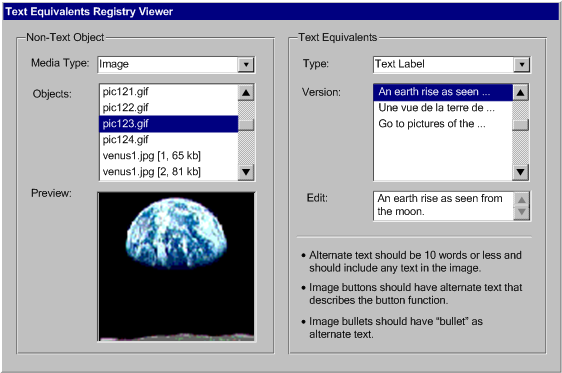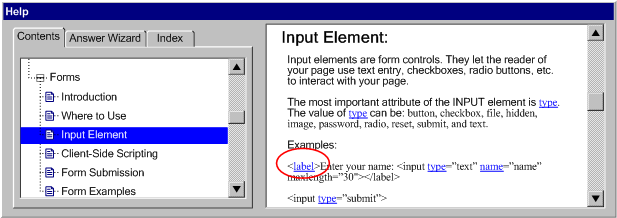This support includes prompting and assisting the author to create accessible
web content (Checkpoint 3.1), especially for information that cannot be generated
automatically, checking for accessibility problems (Checkpoint 3.2), and assisting
in the repair of accessibility problems (Checkpoint 3.3). In performing these
functions, the authoring tool must avoid including automatically generated equivalent
alternatives or previously authored equivalent alternatives without author consent
(Checkpoint 3.4). The authoring tool may also provide automated means for managing
equivalent alternatives (Checkpoint 3.5) and provide accessibility status summaries
(Checkpoint 3.6).
Accessibility-related documentation provides support and guidance to the author.
The documentation must accommodate the various levels of author familiarity
with web content accessibility issues. The checkpoint requirements include documenting
accessible content promoting features (Checkpoint 3.7), and ensuring that documentation
demonstrates authoring practices and workflow processes that result in accessible
content (Checkpoint 3.8).
@@more help designing well - e.g. alternatives to image
maps@@
A less effective approach to prompting and assisting the author to create accessible
content is to allow problems to be created and then address them later as part
of checking (checkpoint 3.2) and correcting (checkpoint
3.3). @@However, since may leave the author uninformed
of accessibility problems for so long that when they are finally informed, the
full weight of the accumulated problems may be overwhelming@@. Therefore,
it is preferable to begin guiding the author towards the production of accessible
content before accessibility problems have actually been introduced.
It is important to note that when information is required of the author, it
is crucial that that information be correct and complete.
This is most likely to occur if the author has been convinced to provide the
information voluntarily. Therefore, overly restrictive mechanisms are not recommended
for meeting this checkpoint.



 |
Technique 3.1.2: Consider that prompting
and assisting the author to follow various regarding different types
of accessible authoring practices can involve different interfaces mechanisms
(see below).[@@new, changed@@] |
| |
3.1.2(1):
Prompting and assisting for short text labels (e.g. alternate text, titles,
short text metadata fields, rubies for ideograms):
[@@changed@@]
- (a) Since prompts for short text strings are usually intended to elicit
entries of ten words or less, they can be afforded relatively little
screen real estate.
- (b) A rendered view of the object can be provided
for the author to examine while composing the label.
- (c) Short text labels are a good candidate for
storage and reuse (see Techniques
for ATAG checkpoint 4.4)
- (d) Automated routines can be implemented to detect
and offer labels for objects serving special functions (e.g. "decorative",
"button", "spacer", "horizontal rule",
etc.).
- (e) An editable text entry box with a drop-down
list can accommodate new text entry as well as the option to select
from reusable or special function label text.
|



 Example 3.1.2(1a): This illustration shows a authoring interface for encouraging
description reuse. It is comprised of a drop-down list is shown with several
short labels for the same image. Notice that one of the labels in the
list is in a different language (French).The author must be able to create
a new label if the stored strings are not appropriate. (Source: mockup
by AUWG)
Example 3.1.2(1a): This illustration shows a authoring interface for encouraging
description reuse. It is comprised of a drop-down list is shown with several
short labels for the same image. Notice that one of the labels in the
list is in a different language (French).The author must be able to create
a new label if the stored strings are not appropriate. (Source: mockup
by AUWG)
 [longdesc
missing] [longdesc
missing]
|
 Example 3.1.2(1b): This illustration shows a code-based authoring interface
for short text label prompting. The author has just typed quotation marks
(") to close the
Example 3.1.2(1b): This illustration shows a code-based authoring interface
for short text label prompting. The author has just typed quotation marks
(") to close the href attribute. (Source: mockup by
AUWG)
 [longdesc
missing] [longdesc
missing]
|
| |
3.1.2(2):
Prompting and assisting for multiple text labels (e.g. image map area
labels): [@@changed@@]
- (a) Prompts for image map text labels can be similar to those for
short text labels with allowance
made for rapidly adding several labels for one image map.
- (b) A preview of the image map areas can be provided.
- (c) The URI of the image map areas can be provided.
- (d) The tool can offer to automatically generate a set of plain text
links from the labels.
|



 Example 3.1.2(2): This illustration shows an authoring interface for image
map area text label prompting. It is comprised of a list with two columns.
In the right-hand column is the URL for each image map area. This can
be used as a hint by the author as they fill in a label text entry in
the left-hand column. A checkbox at the bottom provides the option of
using this label text to create a set of text links below the image map.
(Source: mockup by AUWG)
Example 3.1.2(2): This illustration shows an authoring interface for image
map area text label prompting. It is comprised of a list with two columns.
In the right-hand column is the URL for each image map area. This can
be used as a hint by the author as they fill in a label text entry in
the left-hand column. A checkbox at the bottom provides the option of
using this label text to create a set of text links below the image map.
(Source: mockup by AUWG)
 [longdesc
missing] [longdesc
missing]
|
| |
3.1.2(3):
Prompting and assisting for long text descriptions (e.g. longdesc text,
table summaries, site information, long text metadata fields): [@@changed@@]
- (a) The author can first be prompted as to whether the inserted object
is adequately described. Providing a "no images" view of the
page may help them decide.
- (b) If the short description is inadequate, the author can be prompted
for the location of a pre-existing description.
- (c) If the author needs to create a description,
a special writing utility can be provided (that can include a rendered
view of the object and description writing pointers).
- (d) Long descriptions are an good candidate for storage and reuse
(see Techniques for ATAG checkpoint
4.4)
- (e) Automated routines may be possible to detect
and ignore some objects that do no require long text descriptions (e.g.
bullets, spacers, horizontal rules).
|



 Example 3.1.2(3): This illustration shows an authoring interface for long
text description prompting. A "description required" checkbox
controls whether the rest of the interface is available. If a description
is required, the author then has the choice of opening an existing description
file or writing (and saving) a new one. (Source: mockup by AUWG)
Example 3.1.2(3): This illustration shows an authoring interface for long
text description prompting. A "description required" checkbox
controls whether the rest of the interface is available. If a description
is required, the author then has the choice of opening an existing description
file or writing (and saving) a new one. (Source: mockup by AUWG)
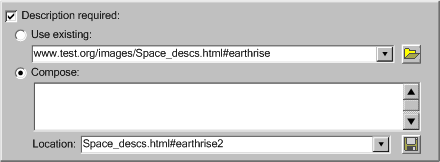 [longdesc missing]
[longdesc missing]
|
| |
3.1.2(4): Prompting and assisting for form field labels:
[@@changed@@]
- (a) This can take the form of a utility that walks the author through
the existing form fields and queries them to select existing text that
is serving as a label or to enter a label.
(b) This can be included in a "form clean-up"
utility. |
| |


 Example 3.1.2(4): This
illustration shows a form properties list that allows the
Example 3.1.2(4): This
illustration shows a form properties list that allows the
user author to simultaneously decide the field labels, tab
order, form field place holders and accesskeys. (Source: mockup by AUWG)
 [longdesc
missing] [longdesc
missing]
|
| |
3.1.2(5): Prompting and assisting for form field place-holders:
[@@changed@@]
- (a) Prompts for form field place-holders can be similar to those for
short text labels.
- (b) Authors could have the option of directly selecting nearby text
strings that are serving implicitly as labels.
(c) This can be included in a "form clean-up"
utility. |
| |
3.1.2(6): Prompting and assisting for TAB order definitions:[@@changed@@]
- (a) The author can be provided with a numbering tool that they can
use to select controls to create a TAB preferred sequence. (See Example
3.1.2(4))
- (b) Where there are only a few links that change in each page of a
collection, a tool can ask the author to confirm whether these links
receive focus first. If so, then the tool can appropriately update the
tabindex order.
(c) This can be included in a "form clean-up"
utility.
|
| |
3.1.2(7): Prompting and assisting for accesskeys: [@@changed@@]
- (a) Authors can be prompted with a list of links that are candidates
for accesskeys because they are common to a number of pages in a site.
- (b) Accesskey lists can be managed to ensure consistency
across sites and to prevent conflicts within pages.
|
 Example 3.1.2(7): This illustration shows a code-based authoring interface
suggesting accesskey values. Notice that "m" is the first suggestion,
as it is the first letter of the link text, "moon". "c"
does not appear in the list as it is already used elsewhere in the document.
(Source: mockup by AUWG)
Example 3.1.2(7): This illustration shows a code-based authoring interface
suggesting accesskey values. Notice that "m" is the first suggestion,
as it is the first letter of the link text, "moon". "c"
does not appear in the list as it is already used elsewhere in the document.
(Source: mockup by AUWG)
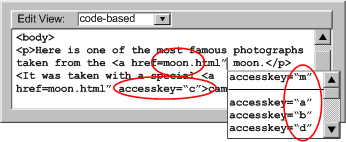 [longdesc
missing] [longdesc
missing]
|
| |
3.1.2(8): Prompting and assisting for contrasting colors:
[@@changed@@]
- (a) When a foreground or background color is defined the color choices
provided to the author can be pre-screened for contrast.
- (b) Color palettes can be assembled with problematic colors excluded
(see Example 3.1.2(9)) or flagged.
|



 Example 3.1.2(9):
This illustration shows an authoring interface for choosing a
text color. The palette has been filtered so that sufficient contrast
between the text and the current background color is assured. (Source:
mockup by AUWG)
Example 3.1.2(9):
This illustration shows an authoring interface for choosing a
text color. The palette has been filtered so that sufficient contrast
between the text and the current background color is assured. (Source:
mockup by AUWG)
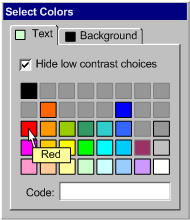 [longdesc
missing] [longdesc
missing]
|
| |
3.1.2(10):
Prompting and assisting for audio/video transcripts:
[@@changed@@]
- (a) The author can be prompted for the location of a pre-existing
transcript (see Example 3.1.2(10)).
- (b) Although transcript writing is a complex process for long media
files, tools can include simple transcription writing suites, with built-in
media players, for short media files.
- (c) Transcripts are a good candidate for storage and reuse (see Techniques
for ATAG checkpoint 4.4)
|



 Example 3.1.2(10):
This illustration shows an authoring interface for embedding a video.
The tool automatically detects whether captions, video transcript, described
audio, or signed translation is present. For some items, links to utilities
to create them are available. (Source: mockup by AUWG)
Example 3.1.2(10):
This illustration shows an authoring interface for embedding a video.
The tool automatically detects whether captions, video transcript, described
audio, or signed translation is present. For some items, links to utilities
to create them are available. (Source: mockup by AUWG)
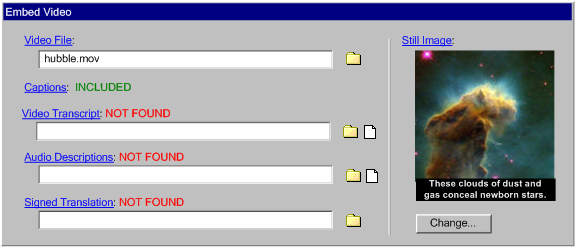 [longdesc
missing] [longdesc
missing]
|
| |
3.1.2(11):
Prompting and assisting for audio/video captions:
- (a) The author can be prompted for the location of a captioned version
of a video (See Example 3.1.2(10)).
- (b) The creation of captions can be a time consuming process, but
public domain tools do exist for adding relatively simple captions (e.g.,
MAGpie).
|
| |
3.1.2(12):
Prompting and assisting for audio descriptions for video:
- (a) The author can be prompted for the location of a described version
of a video (See Example 3.1.2(10)).
- (b) The recording of traditional video descriptions (that are encoded
into the video file where silent periods occur in the original soundtrack)
is a complex process that may be beyond the average author. However,
technologies are becoming available that allow the audio description
files to be stored separately, to be played only if requested by the
author.
|
| |
3.1.2(13):
Prompting and assisting for signed translation for audio/video:
- (a) The author can be prompted for the location of a version of an
audio or video file with signed translation (See Example
3.1.2(10)).
- (b) The creation of signed translation video files is assumed to be
beyond the average author, but new technologies (signing avatars) are
being developed for automated sign language animation to be generated
from text.
|
| |
3.1.2(14):
Prompting and assisting for still images of video:
- (a) The author can be prompted for the location of a still image (See
Example 3.1.2(10)).
- (b) The tool can provide a utility for grabbing still images from
video.
|
| |
3.1.2(15): Metadata:
[@@changed, metadata is actually just a special case of all the
other things in this list @@]
(a) Ask authors for information about a
page or site. If its function is known (see also WCAG
checkpoint 13.9) add this information as metadata. (b) Metadata retrieval standards can be supported.KM(new) (c) Check for DOCTYPE and refer to
Help if author is unsure of which to chooseKM(new) (d) Check that Metatags do not violate
WCAG such as refreshing not controllable by author. |
| |
3.1.2(15): Prompting
and assisting for document structure:
[@@this could be greatly expanded to
take into account highly structured (e.g. XSLT)
authoring @@]
- (a) The tool can offer to
transform presentation markup that is
misused to convey structure into structural markup, with style
sheets used to retain the same appearance.
[@@split and changed@@]
- (b) Formatting conventions such as a number of consecutive paragraphs
beginning with a bullet character (this may be a "bullet" or another
punctuation character like asterisk or dash "-") can be used to automatically
identify lists.
- (c) Authors of DTDs or Schemas can be prompted to specify explicit
structure (e.g. nesting)
|
 Example
3.1.2(15a): This illustration shows a tool that prompts for structural
information. (Source: mockup by AUWG) Example
3.1.2(15a): This illustration shows a tool that prompts for structural
information. (Source: mockup by AUWG)
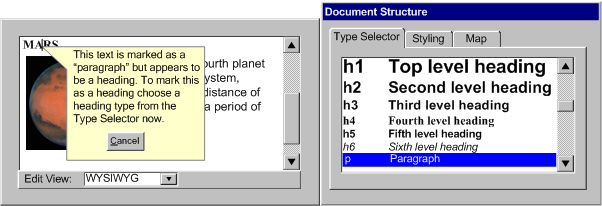 [longdesc
missing] [longdesc
missing]
|
| |
3.1.2(16): Prompting and assisting for
tabular structure:
[@@added
and likely will include many more techs@@]
- (a) The tool can prompt the author
to identify tables as used for layout or data or implement automated
detection mechanisms.
- (b) The author can be prompted to provide
header information.
@@PJ indicated he
would work on this@@
- (c) The author can be prompted to group columns, rows, or blocks of
cells that are related.
@@PJ indicated he
would work on this@@
- (d) The tool can provide the author with a linearized view of tables
(as tablin does).
@@KM remove this->@@ For layout tables, this version can be offered
as alternatives.
|
 Example 3.1.2(16): This illustration shows a tool that
prompts the author as to whether the top row of a table is a row of table
headers. (Source: mockup by AUWG)
Example 3.1.2(16): This illustration shows a tool that
prompts the author as to whether the top row of a table is a row of table
headers. (Source: mockup by AUWG)
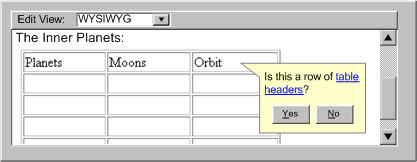 [longdesc
missing] [longdesc
missing]
|
| |
3.1.2(17): Prompting and assisting for
style sheets:
[@@added
and likely will include many more techs@@]
- (a) The tool can offer to
transform structural markup that is misused for style into style sheets.
[@@changed@@]
- (b) The tool can allow the author to create style rules based on the
formatting properties of an element, and then apply the rule to other
elements in the document.
- (c) The tool can provide a utility for editing
the layout and styling effects independently of the text content.
- (d) The author can be asked to identify headings and subheadings.
- (e) Formatting patterns can be recognized and converted to style rules.
- @@Re-worked by JR from TB idea:@@
- @@From TB, edits by JR@@
- @@ALL OF THIS SHOULD GO INTO THE START OF 3.1@@Scenario -
- At the beginning of the authoring session, the author selects in which
form the assistance will arrive, as well as when (how often-determined
by the tool?)
- , as well as how much information to provide (short or long "length").
- The author should also be given the option of not getting any assistance
of this type at all?
- The author should have the option of changing previously-given settings
at some point into the authoring session?
- Given this previous author-supplied information, the tool would present
assistance according to the author's wishes. For example, the tool might
"intelligently" determine when the result of a "current"
authoring action may have style-sheet accessibility implications (according
to the author's wishes mentioned previously), determine what particular
style-sheet accessibility implications might be present (from the following
list-NOT EXHAUSTIVE), and as a result of such determination present
appropriate items from the following list (with the goal of developing
a positive attitude towards accessibility in the author):
- The tool can offer prompting and/or assistance on @@USING STYLE SHEETS@@:
- to control fonts, colors, text sizes
- to specify fallback fonts to promote accessible content
- to specify font characteristics to promote accessible content
- and HTML elements to control fonts to promote accessible content
- to usw color contrast to promote accessible content[@@move-see
3.1.2(9)@@]
- specifying colors to promote accessible content[@@duplicate? -
could all color related items be bundled in 3.1.2(9)@@]
- specifying foreground and background contrast to promote accessible
content[@@duplicate? - could all color related items be bundled
in 3.1.2(9)@@]
- specifying fore- and background colors to promote accessible content
[@@duplicate? - could all color related items be bundled in 3.1.2(9)@@]
- conveying information through multiple means (not just color)
- using relative units of measure
- using of absolute units of measure
- creating stylized text with CSS rather than using raster images
- formatting and positioning of text
- using text style effects
- creating rules and borders
- using text equivalents for content generated by style sheets
- using generated content in the DOM[@@move@@]
- providing contextual clues in lists [@@move@@]
- creating layout, positioning, layering, and alignment
- creating null alt-text to promote accessible content[@@move -
part of 3.1.2(1)@@]
- providing good structural markup for graceful degradation to
promote accessible content[@@move@@]
- using scripting and style sheets
- using ACSS to create auditory presentation
- providing access to alternative representations of content [@@move@@]
- using media types properly
|
| |
3.1.2(18): Prompting and assisting for clearly written text:
[@@changed@@]
- (a) The author can be prompted to specify a default language of a
document.
- (b) A thesaurus function can be provided.
- (c) A dictionary lookup system can recognize changes of language,
abbreviations or acronyms.
- (d) The author can be prompted for expansions
of acronyms, recognizable in some languages as collections of uppercase
letters.
- (e) Provide an automated reading level status.
(new)
|
 Example 3.1.2(19): This illustration shows an authoring
interface for indicating the reading level of a page and whether it exceeds
a limit determined by the author's preference settings. (Source: mockup
by AUWG)
Example 3.1.2(19): This illustration shows an authoring
interface for indicating the reading level of a page and whether it exceeds
a limit determined by the author's preference settings. (Source: mockup
by AUWG)
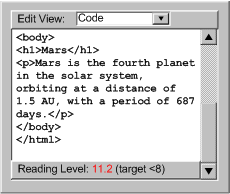 [longdesc missing]
[longdesc missing]
@@BF: maybe add section to 3.1.2 about guiding author
towards use of XML/XSLT (i.e. most up to date formats)@@ |
| |
3.1.2(20): Prompting and assisting for device
independent handlers:
[@@NEW@@]
- (a) During applet development, the author can be prompted to include
device-independent means of activation.
- @@more needed@@
@@BF: what about authoring javascript - e.g. making
sure event handlers are device independent, where does javascript place
content (eg. popup menus), maybe having a very rich Javascript obligate
author to have an alternate version?@@ |
| |
3.1.2(21): Prompting and assisting for non-text supplements to
text:
[@@changed@@]
- (a) The tool can prompt authors to provide icons for buttons, illustrations
for text, graphs for numeric comparisons, etc.
|
 Example 3.1.2(21): This illustration shows an authoring
interface for prompting the author as to whether a number-rich paragraph
might be made more clear with the addition of a chart or graph. (Source:
mockup by AUWG)
Example 3.1.2(21): This illustration shows an authoring
interface for prompting the author as to whether a number-rich paragraph
might be made more clear with the addition of a chart or graph. (Source:
mockup by AUWG)
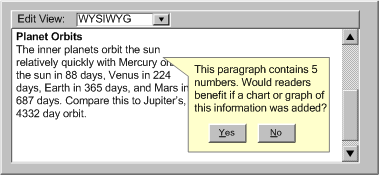 [longdesc
missing] [longdesc
missing]
|
| |
3.1.2(22): Prompting and assisting for other types of accessibility
information:
[@@changed@@]
- (b) Where regions are not easily defined, the author can be asked
to provide information that can be used to generate a form-based input
method and explains how the coordinates input will be used. For example,
for a geographic map the input might be used to look up latitude and
longitude of a point and then give information about that point.
- (c) The author can be asked to provide a link to skip over objects
(since some browsers cause objects to permanently capture the tab focus).
@@new category and T####@@@@proposed
at F2F@@
- (d) The author can be prompted to add a noframes section to the frameset.
Encourage the author to include sufficient links to navigate the site,
and relevant information. For example, where a frameset defines a navigation
frame and a welcome page, include the content of each of these frames
in the noframes.
- (e) When frames used for a mosaic of images, the tool can allow inclusion
of markup files (with images embedded) rather than images directly.
@@new category and T####@@@@proposed
at F2F@@
- (f) Warn about adjacent links
|
| |
Technique 3.1.3: The tool can provide multiple preview
modes and a warning to authors that there are many other less predictable
ways in which a page may be presented (aurally, text-only, text with pictures
separately, on a small screen, on a large screen, etc.). Some possible
document views include:
[@@changed@@]
- an alternative content view (with images and other
multimedia replace by any alternative content),
a draft (no style sheet) view,
- a monochrome view (to test contrast),
- a collapsible structure-only view,
- no scripts view
- no frames view
|
 Example
3.1.3: This illustration shows a WYSIWYG authoring interface with a list
of rendering options displayed. The options include "All" (i.e.
render as in a generic browser), "text-only" (i.e. non-text
items replaced by textual equivalents), "no styles", "no
frames" and "grayscale" (used to check for sufficient contrast).
(Source: mockup by AUWG) Example
3.1.3: This illustration shows a WYSIWYG authoring interface with a list
of rendering options displayed. The options include "All" (i.e.
render as in a generic browser), "text-only" (i.e. non-text
items replaced by textual equivalents), "no styles", "no
frames" and "grayscale" (used to check for sufficient contrast).
(Source: mockup by AUWG)
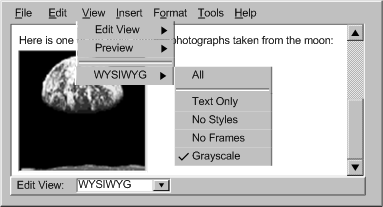 [longdesc
missing] [longdesc
missing]
|
| |
@@Moved from Technique 4.1.5: Accessibility
prompts can include the following wordings@@ |
| |
Technique ???: Assist the author by implementing
XSLT [XSLT] together with an
user authoring interface for expressing transformations (see
Techniques for ATAG checkpoint 2.1).
[@@is this really necessary@@] |
| |
Technique ???: Transform (deprecated) presentation
HTML into style sheets.
@@from ATAG1 4.5@@ |
| |
Technique ???: Provide an outline view that
lets the author clearly see the structure of the document independently
of the specified presentation.
@@new category and T####@@ |
| |
Technique ???: Include lists (marked as lists)
in a collapsible structure view. |
| |
Technique ???: Prompt for alternative content
for applets and programmatic objects. [T0145]
[@@covered by labels and descriptions?@@]
|
| |
Technique ???: Prompt the author for a longdesc
for each frame in a frameset.
[@@covered: should be deleted@@] |
|
Technique ???: Use technologies according to specification.-
This is likely to be handled by the choices made by the tool developers.
General-purpose text editors (e.g. emacs, etc.) would need to make technology
selection recommendations. [@@needs to be moved
out of here@@] |
| |
Technique ???: Prompt for server-side alternatives
for essential client-side scripts (those used for content and navigation)
and applets.
|



 |
Technique 3.2.1: Consider the level of automation
to be used for checking (and informing). Options include:
Manual, Semi-Automated and Automated.[@@new@@] |
1.
Manual (not automated): In manual checking, the tool provides
the author with instructions for detecting a problem, but does not automate
the task of detecting the problem in any meaningful way. As a result,
the author must decide on their own whether or not a problem exists. Manual
checks are discouraged because they can be annoying for authors, especially
when the type of problem in question may be easily detected by a more
automated utility, such as an element missing a particular attribute. |



 Example 3.2.1(a): This illustration shows a dialog box that reminds the
author to check if there are any words in other languages in the document.
The author can move on to the repair stage by pressing "Yes".
(Source: mockup by AUWG)
Example 3.2.1(a): This illustration shows a dialog box that reminds the
author to check if there are any words in other languages in the document.
The author can move on to the repair stage by pressing "Yes".
(Source: mockup by AUWG)
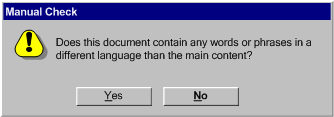 [longdesc
missing] [longdesc
missing]
|
| 2. Semi-Automated:
In semi-automated checking, the tool is able to identify potential problems,
but still requires human judgment by the author to make a final decision
on whether an actual problem exists. Semi-automated checks are usually most
appropriate for problems that are semantic in nature, such as descriptions
of non-text objects, as opposed to purely syntactic problems, such as missing
attributes, that lend themselves more readily to full automation. |



 Example 3.2.1(b): This illustration shows a dialog box that appears once
the tool has detected an image without a description attribute. However,
since not all images require description, the author is prompted to make
the final decision. The author can confirm the at this is indeed an accessibility
problem and move on to the repair stage by choosing "Yes". (Source:
mockup by AUWG)
Example 3.2.1(b): This illustration shows a dialog box that appears once
the tool has detected an image without a description attribute. However,
since not all images require description, the author is prompted to make
the final decision. The author can confirm the at this is indeed an accessibility
problem and move on to the repair stage by choosing "Yes". (Source:
mockup by AUWG)
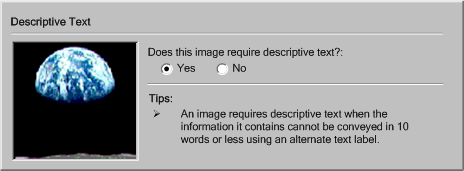 [longdesc
missing] [longdesc
missing]
|
| 3. Automated:
In automated checking, the tool is able to check for accessibility problems
automatically, with no human intervention required. This type of check is
usually appropriate for checks of a syntactic nature, such as the use of
deprecated elements or a missing attribute, in which the meaning of text
or images does not play a role. |
 Example 3.2.1(c): This illustration shows a summary interface for a code-based
authoring tool that displays the results of an automated check. (Source:
mockup by AUWG)
Example 3.2.1(c): This illustration shows a summary interface for a code-based
authoring tool that displays the results of an automated check. (Source:
mockup by AUWG)
 [longdesc missing]
[longdesc missing]
|
 Example 3.2.1(d): This illustration shows an interface that displays the
results of an automated check in a WYSIWYG authoring view using blue squiggly
highlighting around or under rendered elements, identifying accessibility
problems for the author to correct. (Source: mockup by AUWG)
Example 3.2.1(d): This illustration shows an interface that displays the
results of an automated check in a WYSIWYG authoring view using blue squiggly
highlighting around or under rendered elements, identifying accessibility
problems for the author to correct. (Source: mockup by AUWG)
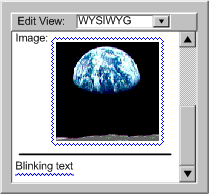 [longdesc missing] [longdesc missing]
|
 Example 3.2.1(e): This illustration shows an authoring interface of an
automated check in a code-level authoring view. In this view, the text
of elements with accessibility problems is shown in a blue font, instead
of the default black font. (Source: mockup by AUWG)
Example 3.2.1(e): This illustration shows an authoring interface of an
automated check in a code-level authoring view. In this view, the text
of elements with accessibility problems is shown in a blue font, instead
of the default black font. (Source: mockup by AUWG)
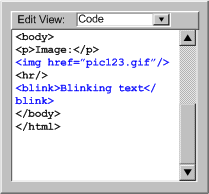 [longdesc
missing] [longdesc
missing]
|



 |
Technique 3.2.2: Consider the timing options to be used
for informing the author of the results of the check. Options include:
Immediate Interruption, Negotiated
Interruption and Scheduled Interruption.[@@new@@]
|
1. Immediate Interruption:
An immediate interruption is the most intrusive timing option because
the attention of the author is actively diverted from the current editing
task by the notification of some issue. This might be achieved, for instance,
by an alert dialog. This type of alert presents multiple usability problems
and should be used sparingly because it interferes with the normal design
workflow. Intrusive warnings are probably only appropriate when the window
of opportunity for correcting a serious accessibility problem is about
to close, such as when an author decides to publish the content in question.
In general, we recommend using the less disruptive timing options. |



 Example 3.2.2(a): This illustration shows an example of an immediate interruption
of the author's workflow. The author must press the "OK" button
on the dialog box to continue. (Source: mockup by AUWG)
Example 3.2.2(a): This illustration shows an example of an immediate interruption
of the author's workflow. The author must press the "OK" button
on the dialog box to continue. (Source: mockup by AUWG)
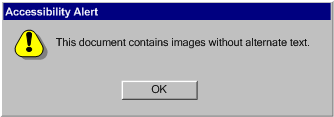 [longdesc missing] [longdesc missing]
|
| 2.
Negotiated Interruption (Preferred): A negotiated interruption
is caused by interface mechanisms (icons, line or color highlighting of
the element, audio feedback, etc.) that alert the author to a problem,
but remain flexible enough to allow the author to decide whether to take
immediate action or address the issue at a later time. Since negotiated
interruptions are less intrusive than immediate interruptions they can
often be better integrated into the design workflow and have the added
benefit of informing the author about the distribution of errors within
the document. Although some authors may choose to ignore the alerts completely,
it is not recommended that authors be forced to fix problems.
Instead, it is recommended that, at some major editing
event (e.g., when publishing), the tool should remind the author of
the continuing unresolved accessibility issue. |
 Example 3.2.2(b): This illustration shows an example of a negotiated interruption.
The author is made aware of problems detected automatically by means of
a blue squiggly line around or under rendered elements with accessibility
problems. The author can still decide to address the problems at a later
time. (Source: mockup by AUWG)
Example 3.2.2(b): This illustration shows an example of a negotiated interruption.
The author is made aware of problems detected automatically by means of
a blue squiggly line around or under rendered elements with accessibility
problems. The author can still decide to address the problems at a later
time. (Source: mockup by AUWG)
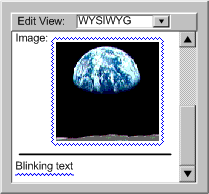 [longdesc missing] [longdesc missing]
|
3. Scheduled Interruption:
A scheduled interruption is one in which the author has set the tool to
alert them of accessibility issues on a configurable
schedule. One option for the schedule might be to have prompts associated
with the interface mechanisms for significant authoring events such as
saving, exiting, publishing, or page generation,
etc. At the significant authoring event, the author would be informed
of the problem, while at the same time they would not be prevented
from saving, publishing, printing, etc. For example, a "save as" dialog
could display an accessibility warning and an option to launch a correction
utility after saving (see Figure 3.2.7).
A potential downside of this type of prompting is that by the time the
prompt is displayed (publishing, etc.), the author may not have sufficient
time to make the required changes, especially if they are extensive. |


 Example 3.2.2(c): This illustration shows a "Save As" dialog
box that is an example of a scheduling mechanism for a scheduled interruption.
The author has the option of turning on or off a checking session immediately
following the save operation. The author's preference should be retained
for the next save operation. (Source: mockup by AUWG)
Example 3.2.2(c): This illustration shows a "Save As" dialog
box that is an example of a scheduling mechanism for a scheduled interruption.
The author has the option of turning on or off a checking session immediately
following the save operation. The author's preference should be retained
for the next save operation. (Source: mockup by AUWG)
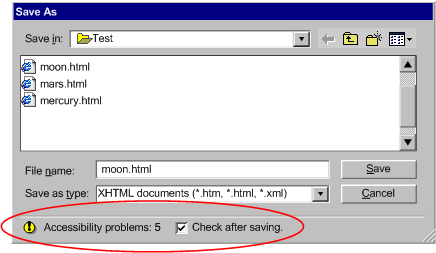 [longdesc
missing] [longdesc
missing]
|




|
Technique 3.2.3: The Techniques For
Accessibility Evaluation And Repair Tools [WAI-ER] Public Working
Draft document can be consulted for evaluation and repair algorithms related
to WCAG 1.0.
The WAI Evaluation and Repair group [WAI-ER] is developing a
document that discusses detailed techniques for testing the accessibility
of content according to the Web Content Accessibility Guidelines, and methods
of repairing it. A draft of that document is available [AUTO-TOOL]. |




|
Technique 3.2.4: Accessibility problems
can be detected and immediately highlighted when documents are opened, when
an editing or insertion action is completed, or while an author is editing.
CSS classes can be used to indicate accessibility problems enabling the
author to easily configure the presentation of errors.
|




|
Technique 3.2.5: The author can be
alerted to accessibility problems when saving.
|




|
Technique 3.2.6: Accessibility problems can be
highlighted using strategies similar to spell checking within a word processor.@@covered
in GL4?@@ |




|
New Technique: Accessibility alerts within the document
can be linked to context sensitive help. (See the Techniques for ATAG checkpoint 6.1)
|




|
Technique 3.2.7: Where the tools cannot test for
accessibility errors the author with the necessary information, wizards,
etc. to check for themselves.
@@covered in discussion of types of prompts@@ |




|
Technique 3.2.8: Alerts for high priority WCAG
checkpoints can be included in the default configuration.
|




|
Technique 3.2.9: Provide an editing view that shows equivalent alternatives
in the main content view to make it clear that they are necessary. This
will make it obvious when they are missing.
@@covered in technique 3.1.3?@@ |




|
Technique 3.2.10: Preference utilities
can be designed to allow authors to choose different alert levels based
on the priority of authoring accessibility recommendations.
|




|
Technique 3.2.11: If intrusive warnings
are used, a means can be provides for the author to quickly set the warning
to unobtrusive to avoid frustration.
|




|
Technique 3.2.12: The WAI Evaluation
and Repair group has produced a Public Working Draft of techniques for evaluating
and repairing HTML according to WCAG 1.0 [AERT].
@@duplicate of 3.2.3@@ |



 |
Technique 3.3.1: Consider the level of automation to
be used for repairing errors. Options include:
Manual, Semi-Automated
and Automated.[@@new@@] |
1. Manual:
In manual repairing, the tool provides the author with instructions for
making the necessary correction, but does not automate the task in any
substantial way. For example, the tool may move the cursor to start of
the problem, but since this is not a substantial automation, the repair
would still be considered "manual". Manual correction tools
leave it up to the author to follow the instructions and make the repair
by themselves. This is the most time consuming option for authors and
allows the most opportunity for author error. |
 Example 3.3.1(a): This illustration shows a sample manual repair. The
problems have already been detected in the checking step and the selected
the offending elements in a code view have been highlighted. However,
when it comes to repairing the problem, the only assistance that the tool
provides is a context sensitive hint. The author is left to make sense
of the hint and perform the repair without any automated assistance. (Source:
mockup by AUWG)
Example 3.3.1(a): This illustration shows a sample manual repair. The
problems have already been detected in the checking step and the selected
the offending elements in a code view have been highlighted. However,
when it comes to repairing the problem, the only assistance that the tool
provides is a context sensitive hint. The author is left to make sense
of the hint and perform the repair without any automated assistance. (Source:
mockup by AUWG)
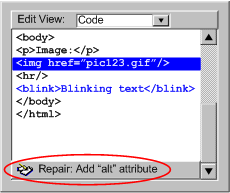 [longdesc missing] [longdesc missing]
|
| 2.
Semi-Automated: In semi-automated repairing, the tool can provide
some automated assistance to the author in performing corrections, but
the author's input is still required before the repair can be complete.
For example, the tool may prompt the author for a plain text string, but
then be capable of handling all the markup required to add the text string
to the content. In other cases, the tool may be able to narrow the choice
of repair options, but still rely on the author to make the final selection.
This type of repair is usually appropriate for corrections of a semantic
nature. |
 Example 3.3.1(b): This illustration shows a sample of a semi-automated
repair in a WYSIWYG editor. The author has right-clicked on an image highlighted
by the automated checker system. The author must then decide whether the
label text that the tool suggests is appropriate. Whichever option the
author chooses, the tool will handle the details of updating the content.
(Source: mockup by AUWG)
Example 3.3.1(b): This illustration shows a sample of a semi-automated
repair in a WYSIWYG editor. The author has right-clicked on an image highlighted
by the automated checker system. The author must then decide whether the
label text that the tool suggests is appropriate. Whichever option the
author chooses, the tool will handle the details of updating the content.
(Source: mockup by AUWG)
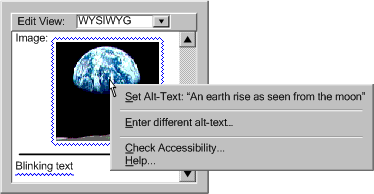 [longdesc missing] [longdesc missing]
|
3.
Automated: In automated tools, the tool is able to make repairs
automatically, with no author input required. For example, a tool may be
capable of automatically adding a document type to the header of a file
that lacks this information. In these cases, very little, if any,
user authoring interface is required. This type of repair
is usually appropriate for corrections of a syntactic or repetitive nature. |
 Example 3.3.1(c): This illustration shows a sample of an announcement
that an automated repair has been completed. An "undo " button
is provided in case the author wishes to reverse the operation. In some
cases, automated repairs might be completed with no
Example 3.3.1(c): This illustration shows a sample of an announcement
that an automated repair has been completed. An "undo " button
is provided in case the author wishes to reverse the operation. In some
cases, automated repairs might be completed with no
user authoring interface presence at all. (Source: mockup
by AUWG)
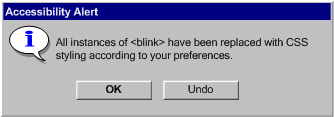 [longdesc
missing] [longdesc
missing]
|



 |
Technique 3.3.2: Consider implementing
a special-purpose correcting interface. [@@new@@]When
problems require some human judgment, the simplest solution is often to
display the property editing mechanism for the offending element. This has
the advantage that the author is already somewhat familiar with the interface.
However, this practice suffers from the drawback that it does not necessarily
focus the author's attention on the dialog control(s) that are relevant
to the required correction. Another option is to display a special-purpose
correction utility that includes only the input field(s) for the information
currently required. A further advantage of this approach is that additional
information and tips that the author may require in order to properly provide
the requested information can be easily added. Notice that in the figure,
a drop-down edit box has been used for the short text label field. This
technique might be used to allow the author to select from text strings
used previously for the alt-text of this image (see ATAG
Checkpoint 3.5 for more). |



 Example 3.3.2: This illustration
shows a sample of a special-purpose correction interface. The tool supports
the author's repair task by providing a description of the problem, a
preview (in this case of the image missing a label), tips for performing
the repair, possible repair options (archived from previous repairs) and
other information (in this case the name of the image file). (Source:
mockup by AUWG based on A-Prompt)
Example 3.3.2: This illustration
shows a sample of a special-purpose correction interface. The tool supports
the author's repair task by providing a description of the problem, a
preview (in this case of the image missing a label), tips for performing
the repair, possible repair options (archived from previous repairs) and
other information (in this case the name of the image file). (Source:
mockup by AUWG based on A-Prompt)
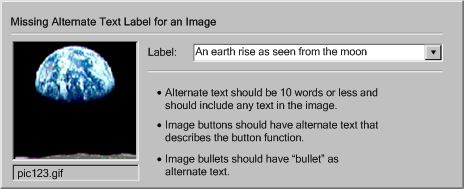 [longdesc missing] [longdesc missing]
|



 |
Technique 3.3.3: Checks can be automatically sequenced.@@changed@@ |
| In cases where there are likely to be many accessibility problems, it
may be useful to implement a checking utility that presents accessibility
problems and repair options in a sequential manner. This may take
a form similar to a configuration wizard or a spell checker (see
Figure 3.3.5). In the case of a wizard, a complex interaction is broken
down into a series of simple sequential steps that the author can complete
one at a time. The later steps can then be updated "on-the-fly"
to take into account the information provided by the author in earlier steps.
A checker is a special case of a wizard in which the number of detected
errors determines the number of steps. For example, word processors have
checkers that display all the spelling problems one at a time in a standard
template with places for the misspelled word, a list of suggested words,
and "change to" word. The author also has correcting options,
some of which can store responses to affect how the same situation can be
handled later. In an accessibility problem checker, sequential prompting
is an efficient way of correcting problems. However, because of the wide
range of problems the checker needs to handle (i.e. missing text, missing
structural information, improper use of color, etc.), the interface template
will need to be even more flexible than that of a spell checker. Nevertheless,
the template is still likely to include areas for identifying the problem
(WYSIWYG or code-based according to the tool), suggesting multiple solutions
and choosing between or creating new solutions. In addition, the dialog
may include context-sensitive instructive text to help the author with the
current correction. |



 Example 3.3.3: This illustration shows an example of a sequential accessibility
checker, the special-purpose correction interface from Example
3.3.2 is supplemented with navigational controls for moving backwards
and forwards through the list of repair tasks. (Source: mockup by AUWG
based on A-Prompt)
Example 3.3.3: This illustration shows an example of a sequential accessibility
checker, the special-purpose correction interface from Example
3.3.2 is supplemented with navigational controls for moving backwards
and forwards through the list of repair tasks. (Source: mockup by AUWG
based on A-Prompt)
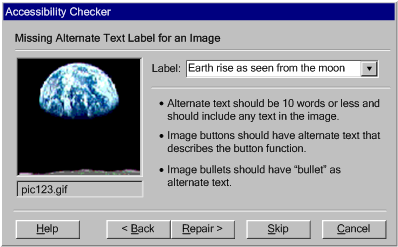 [longdesc missing] [longdesc missing]
|



 |
Technique 3.3.4: When authoring
tools produce content in real-time, it is usually no longer possible to
delay addressing accessibility problems until arbitrary point in the future.
At the same time, due to the time pressure, authors in real-time environments
tend to be less receptive to intrusive prompts. Nevertheless, tools that
allow this kind of authoring (see Figure 3.3.6)
should still take accessibility issues into account by supporting the
following:
- Determination of Participant
Requirements: If real-time authoring is consumed by individuals
with no special communicative needs, there may be no need for real-time
prompting. However, as with any other Web content it is often impossible
for the author to know all of the needs of the actual or potential participants.
Therefore, the best practice is to create real-time content that conforms
with WCAG to the greatest extent possible. However, when this is not
possible, real-time authoring tool might be able to facilitate graceful
degradation of accessibility by polling the participants (see "Request
whiteboard descriptions" checkbox in the figure) or in some cases
checking the profiles of participants @@REF@@ to determine which types
of accessibility practices would offer the greatest advantage in the
the short time available. Once this information is compiled, the tool
can prompt the author or see Assistant/Peer Author)
to correct problems appropriately (preferably during Preparation
Time). When it is not possible to know, with certainty, the needs
of all participants, the tool should still assume that accessible content
is required. This is especially true if the results of the session will
be archived.
- Assistant/Peer Author:
In some cases, it may be possible to designate one or more secondary
authors in the live community, who can receive and respond to prompts
for supplemental information generated as the primary author proceeds
uninterrupted. The secondary author might be an unrelated specialist,
analogous to Sign language interpreter, a co-author (helpful for describing
technical drawings, etc.), or in some situations any member of the session
audience (i.e. a peer).
- Preparation Time:
If the authoring tool allows the author time to pre-assemble materials
for a live presentation (e.g. a professor preparing for an online class),
this authoring is not considered real-time authoring. The authoring
tool has the opportunity and the obligation to support accessible authoring
as described elsewhere in this document.
- Archiving: If
the session will be archived, there may be other opportunities to increase
the accessibility of the content of the archive by guiding the author
through a process to check for and repair accessibility problems after
the real-time session has ended, but prior to archiving.
If it has been determined that the author must provide real-time supplements,
but no preparation time or assistant
author are available, then in addition to allowing the author control
of the nature and timing of prompting, the authoring tool can facilitate
the inclusion of supplements by:
- Implementing the equivalent alternatives management functionality
(see Checkpoint 3.5). This way,
if the author uses an object that has been used before, the tool can
suggest the previously stored alternative, which the author can quickly
accept or decline without substantial workflow disruption.
- Providing a voice recognition capability so that the author's real-time
speech input can be converted into captioning.
|
 Example 3.3.4: This illustration shows an a real-time presentation in
a whiteboard/chat environment. Notice the functionality by which the presenter
or a secondary author (describer) can describe the events on the whiteboard
even as the dialog continues. (Source: mockup by AUWG, based on A-Communicator).
Example 3.3.4: This illustration shows an a real-time presentation in
a whiteboard/chat environment. Notice the functionality by which the presenter
or a secondary author (describer) can describe the events on the whiteboard
even as the dialog continues. (Source: mockup by AUWG, based on A-Communicator).
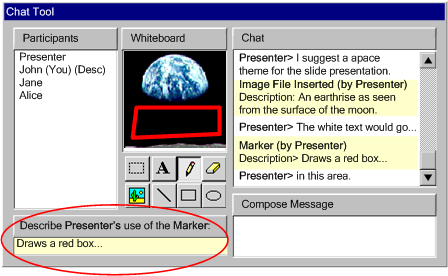 [longdesc missing]
[longdesc missing]
|



 |
Technique 3.3.5: At a minimum, provide context-sensitive
help with the accessibility checking required by ATAG Checkpoint 3.2.
|



 |
Technique 3.3.6: Where a tool is
able to detect site-wide errors, allow the author to make site-wide corrections.
This should not be used equivalents alternatives when
the function is not known with certainty (see
ATAG Checkpoint 3.4).
[@@changed@@] |



 |
Technique 3.3.7: Assist authors
in ways that are consistent with the look and feel of the authoring tool
(See Techniques for ATAG Checkpoint
?.?).
|



 |
Technique 3.3.8: Allow authors
to configuration the nature and timing of the correction process.
|



 |
Technique 3.3.9: Provide a mechanism
for authors to navigate sequentially among uncorrected accessibility errors.
|
| |
Technique 3.3.10: The WAI Evaluation
and Repair group [WAI-ER] has produced a
Public Working Draft of techniques for evaluating and repairing HTML according
to WCAG 1.0 [AERT].@@see 3.2.3@@ |
 [longdesc
missing]
[longdesc
missing] [longdesc
missing]
[longdesc
missing] [longdesc
missing]
[longdesc
missing] [longdesc missing]
[longdesc missing] [longdesc
missing]
[longdesc
missing] [longdesc
missing]
[longdesc
missing] [longdesc
missing]
[longdesc
missing] [longdesc
missing]
[longdesc
missing]


















